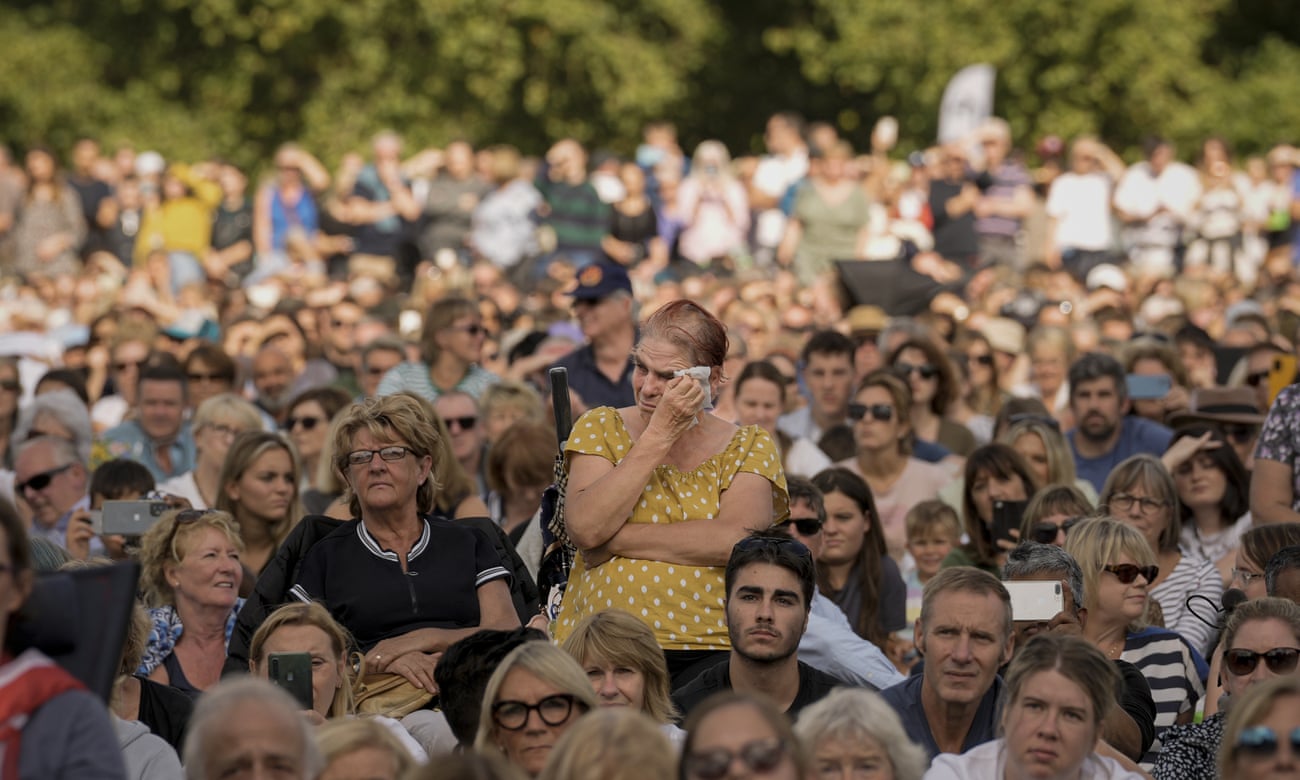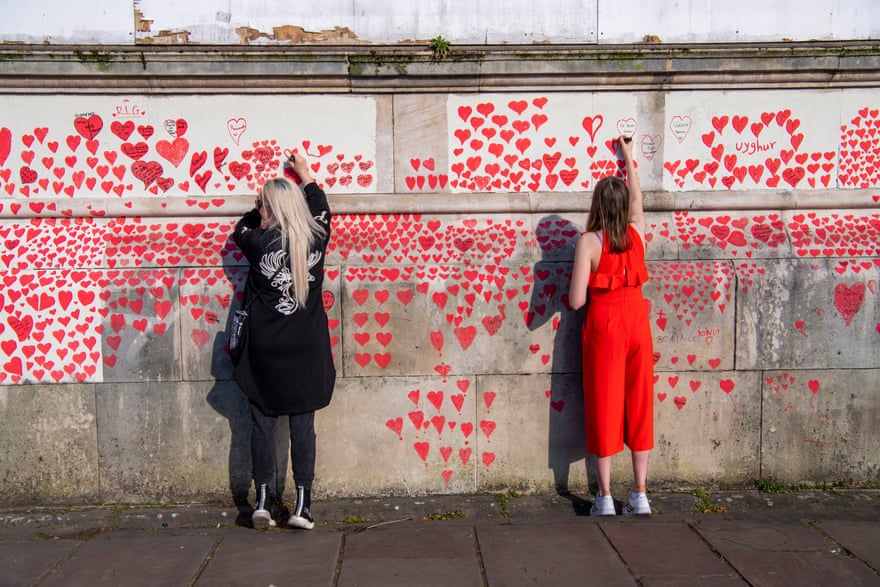‘We need to find our kin, people who speak the same language’: the power of shared grief, from Covid to the Queen

Why are so many of us mourning a queen we never met? Is it about Elizabeth II the person, or what she represented for Britain and the world – or us, and our apparently unrelated sorrows? We talk to psychotherapists, anthropologists – and the bereaved
As many have noted, this period of national mourning has a peculiarly British tinge, with the rain, the queueing, the marmalade sandwiches. People stood through the night, in a miles-long line that ran through central London, to pay their last respects to the Queen, lying in state. The TV coverage was almost soothing in its bland repetition, and its sombre reverence unavoidable.
For those of us of a republican leaning, the whole thing can feel bizarre and alienating, but for many others, the depth of their feeling may have caught them by surprise. “We have a relationship with these public figures,” says Julia Samuel, a psychotherapist who specialises in bereavement. The Queen, in particular, has “been the backdrop of our lives and this connecting thread. She’s the symbol of the mother of the nation and symbol of this idea of predictability, in such a changing, turbulent world. So we have a feeling of loss.” Precisely because of the Queen’s unknowability, we project our emotions on to her. “There’s a feeling of security in having a relationship with someone, particularly if you don’t actually know them, because you can put on to them what you need,” says Samuel.
We have come to know this outpouring of public emotion as collective grief. “The thing about collective grief is that it can put you in touch with your own losses,” says Samuel. “It can be loss of a parent and it reminds you of your mum or dad dying, or it puts you in touch with your mortality. If you have unresolved losses, it can bring lots of other feelings that aren’t necessarily to do with the Queen, that can feel quite overwhelming because it goes to the same place.”

Grief can be comforting, she says, when we are “feeling it at the same time. People feel bonded and have this sense of social safety, and of it reinforcing social ties. I think that’s why in queueing for the vigil or going to the different palaces, people find that calming. What research shows is that having great experiences of loss, you do worse alone than when you have the love and connection to others.” In a close bereavement, you would want this to be with friends and family, says Samuel. “But I also think there is something about strangers feeling like they know each other when they’re coming to put flowers at Buckingham Palace.”
The ritual of this period of mourning has been important, says Samuel. “Rituals hold us together and they give us this sense of meaning. They’re incredibly important in the process of grieving because part of the task of grieving is facing the reality of the loss.” For the people who passed the Queen’s coffin, some visibly upset, it’s about confronting the loss, she says. “You can’t not know that someone has died – it’s not surreal any more, which is often the first response to death. And so that helps you adjust to this new reality. The relationship changes once you know they’ve died – you feel the pain of the loss, but also what can emerge is this idea of continuing bonds, that the memory of the person continues, and our affection or love, in some cases, for this person. The collective memory of the Queen will go on – for centuries, I would imagine.”
We may be mourning what we perceive as the loss of the Queen’s values, says Kate Woodthorpe, director of the Centre for Death and Society at the University of Bath. “Her loss is not necessarily about her as an individual. It’s about what she represented, which was stability, discretion, tolerance, pragmatism, diplomacy – things that feel under threat nowadays.”
We think of collective grief as something new, experienced first perhaps in that intense public emotion after the death in 1997 of another royal, Diana. “But it’s not a new phenomenon,” says David Kessler, a writer and expert on grief. “As far back as we can remember, we’ve gathered in the town square to talk about the most recent death.” The sinking of the Titanic provoked collective grief, he points out. There were two world wars, and we remember victims of the Holocaust. In the mid-20th century, increased media coverage, especially on television, of events started to fuel our collective grief for individual figures. “We saw JFK’s death,” says Kessler. “We saw Princess Diana’s death. Those became big moments.”
The advent of digital media has supercharged it. “We can see the expressions of grief more,” says Aleks Krotoski, a social psychologist. “Certainly in the context of the current moment, grief can be collective across a much, much greater geographical area. We’re able to be in the space, as it were.”
If you watched the people lining the streets as the procession made its way to the Palace of Westminster, a large number were holding their phones up, recording the event. “This moment is on a scale that we’ve never seen, and we probably won’t see again,” says Woodthorpe. “It’s about bearing witness to history – that’s what I think a lot of this is about.” Less benign perhaps, is that there is something “about being seen to bear witness”. As an academic, she has been fascinated by the performative aspect of some of the public grieving – the people who film themselves laying flowers, or take selfies. “Why are they doing it, to what end? Is it about celebrating the Queen and recognising her? Or is it about being a part of something? I suppose what social media has done is create the feeling that if you’re not part of it, you’re missing something significant.”

As a society, we are more willing to bare our hearts than we once were. “Over the last 20 years, we have seen a much bigger recognition about the importance of mental health, and showing your emotion and talking about how you feel,” says Woodthorpe. Grief, though, has largely remained a hidden and isolating experience for those going through it. Kessler believes the bigger scale of collective grief, amplified on social media and in TV coverage, may help us to deal better with more personal losses. “Sometimes we have this belief that grief is weakness, and we don’t talk as openly about it. My hope is that these huge losses that are collective give us more permission not just to talk about the Queen, but to talk more about our own mum and dad, and our other loved ones.”
READ RELATED: 'I'm just not good enough': Words from 'depressive' Instagram post used in note Molly Russell
In developed societies, collective grief feels unusual – but it isn’t in other cultures. “We have a very individualist sense of grief because our societies are quite fractured,” says Susan Hemer, an anthropologist at the University of Adelaide. “Generally, when we have a family member die, the people around us are often not bereaved as well, and so it’s a very individual experience. When you have a collective society – a group that lives more as a community – when somebody dies, generally that person is known to the whole community. The whole community is bereaved, and they all grieve together.”
Much of Hemer’s work has been in Papua New Guinea; after people’s deaths there she saw “this real sense of stopping and sharing time together – just sitting together and talking, sharing food, and stories about the person. What’s really interesting is you can see that type of thing happening now. People are stopping, and they’re talking about memories.” In Australia, people are calling into radio stations with stories of meeting the Queen. “We’re seeing, on a big scale, whole societies stopping – with public holidays – and reflecting. It’s almost like, because she was such an important figure and known to everybody, we’re doing in our societies what happens in these small collectivist societies.”
Grief isn’t just a feeling of sadness, Hemer points out, “but the other emotions that come up with it. We’re also seeing some anxiety about the future. The world has been uncertain the last few years, and the Queen was a steadying figure. We are seeing sadness at her passing but also anxiety about what happens now. I think you’re going to see it in places like Australia – what happens to the Commonwealth?”
Clearly, not all collective griefs are equal. After the death of the Queen – a woman who lived a long life and died in the place she loved, with her family around her – the feeling that characterises this particular mourning period for many people, says Hemer, is a kind of “gentle sorrow”. Kessler agrees: “We don’t have the sense with the Queen that this is a tragedy. Rather, we feel like this is a life well lived. People who lived a long life, we want to celebrate them.”
Other public experiences of loss have been characterised by shock and other emotions. “Usually with a life cut short, we have much more anger,” says Kessler. That was the feeling with Diana, he says. There were other effects – suicide rates went up in the month after her funeral, particularly among young women.
Anger, shock and intense sadness followed tragedies such as the Dunblane massacre, 9/11 and the Grenfell disaster, as they did after the murder by a police officer of George Floyd in the US in 2020. After the death of Floyd, feelings of anger and sadness in the US population “increased to unprecedented levels”, wrote the researchers of a study into the emotional impact, while Black Americans, unsurprisingly, “reported significantly larger increases in depression and anxiety symptoms”. The collective sadness, anger and grief after Grenfell and Floyd – and after the fatal shooting of Chris Kaba by armed police officers in London two weeks ago – fuelled demands for justice.
In October 2020, Fran Hall’s husband, Steve, died from Covid. She is one of several thousand members of the Covid-19 Bereaved Families for Justice UK group, and the collective grief felt by the group, she says, has been both a source of strength – they successfully campaigned for a public inquiry into the UK’s handling of the pandemic – and a comfort. “There has been no national collective recognition that more than 200,000 people are not here any more because of the pandemic. We just needed to find our kin, the people that understand exactly what we’ve experienced, can speak the same language. For many other people who haven’t lost somebody specifically because of the pandemic, life goes on – everyone’s keen to move forward. Whereas for those of us who have been bereaved as a result of Covid, it will never be behind us – it will always be very present.”
Many of the people she has spoken to within the group tell of how conflicted they feel about the national mourning for the Queen, when they weren’t able to participate in their own rituals following the deaths of loved ones – something Hall acknowledges the Queen experienced, too, after the death of her husband. “So to be now sharing in a nation that’s united in grief is quite poignant. This collective mourning is like an outpouring of grief for a nation that’s withheld their grief for a long time. It’s triggering people’s memories of their losses, whether it was a bereavement recently, or 20 or 30 years ago.”

When we speak, she is on her way to join the queue to pay her last respects to the Queen. “My mother was a tremendous fan of the royal family; I know that she would have been standing in that queue today if she’d still been alive,” says Hall. “My husband was a police officer for 30 years in the Met and swore allegiance to the Queen – if he was still here, he’d be coming, too. I think many people are doing what we’re doing to represent people who aren’t with us any more. It’s a magnification of individual personal grief.”
And so Hall will queue, and at some point, as people move slowly forward, she and the many thousands of others will pass the National Covid Memorial Wall, where painted red hearts represent people who lost their lives to coronavirus, and which she helps to maintain every week as a volunteer. The wall, she says, “anchors all of that unacknowledged grief behind people’s closed doors. It’s a public representation of the scale of loss. For it to be part of the Embankment where the queue passes to go see the Queen lying in state, that’s really poignant as well.”
Source: Health & wellbeing | The Guardian





